The only AI platform built on the largest database of echos linked to mortality in the world.
Don’t let inaccuracies and inappropriate referrals obscure the patients who need your care most urgently. EchoSolv™ improves the current standard clinical workflow associated with diagnosis and treatment.
Developed on the largest training set in the world linked to mortality, offering crucial context when evaluating risk.
Intentionally designed to exclude the most common clinical biases, such as gender, race and hemodynamic obfuscations.
Neutralizes the LVOT error amplification in the continuity equation.
Unlike others, EchoSolv™ was trained on hundreds of thousands of cardiologist-approved studies, not unreviewed echos.
Streamlining clinical capacity by helping you prioritize referrals, automatically detect at-risk patients and publish reports.
Referrals aren’t always for the right patient at the right time — but EchoSolv™ automatically flags the most urgent cases for patient prioritization and ensures that the most useful data is automatically generated in the report.
Lower the burden of identifying AVR patients.
Immediately view multi-site population health and performance.
Neutralizes the LVOT error amplification in the continuity equation.
Uphold quality assurance and sonographer standards.
Reduce non-clinical variability in diagnosis and improve the consistency of care management.
We identify the patients as soon as their study is complete, we then put the data in your hands.
Automatic identification of your at-risk patients. Quickly find the patients you are interested in, or review the status of your patient cohort as a whole with powerful filtering options.
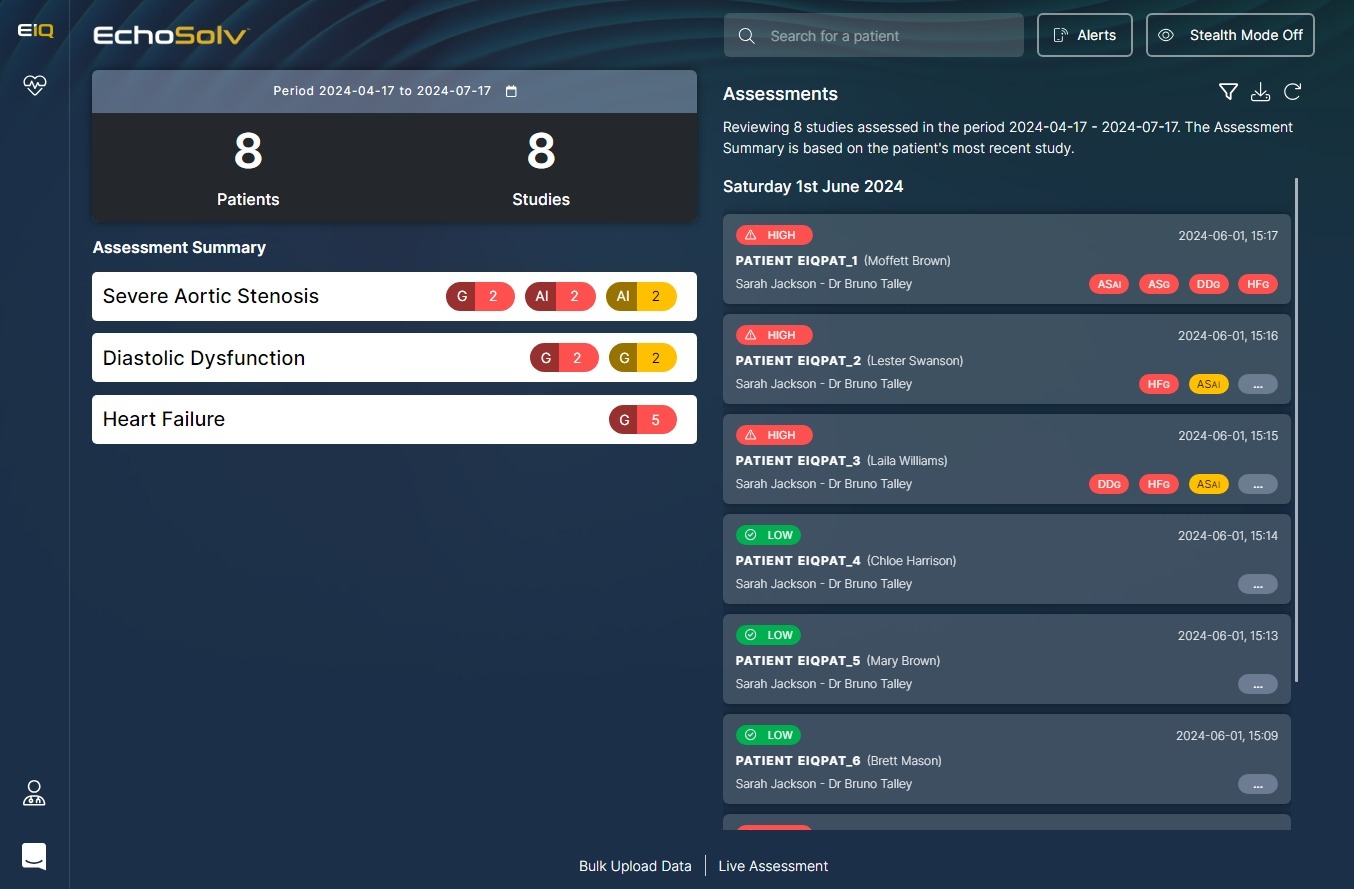
Risk context at a glance — all EchoSolv™ results and echo data in one place. Easy to navigate to patient’s current and historical studies, as well as to view all echo measurement data.
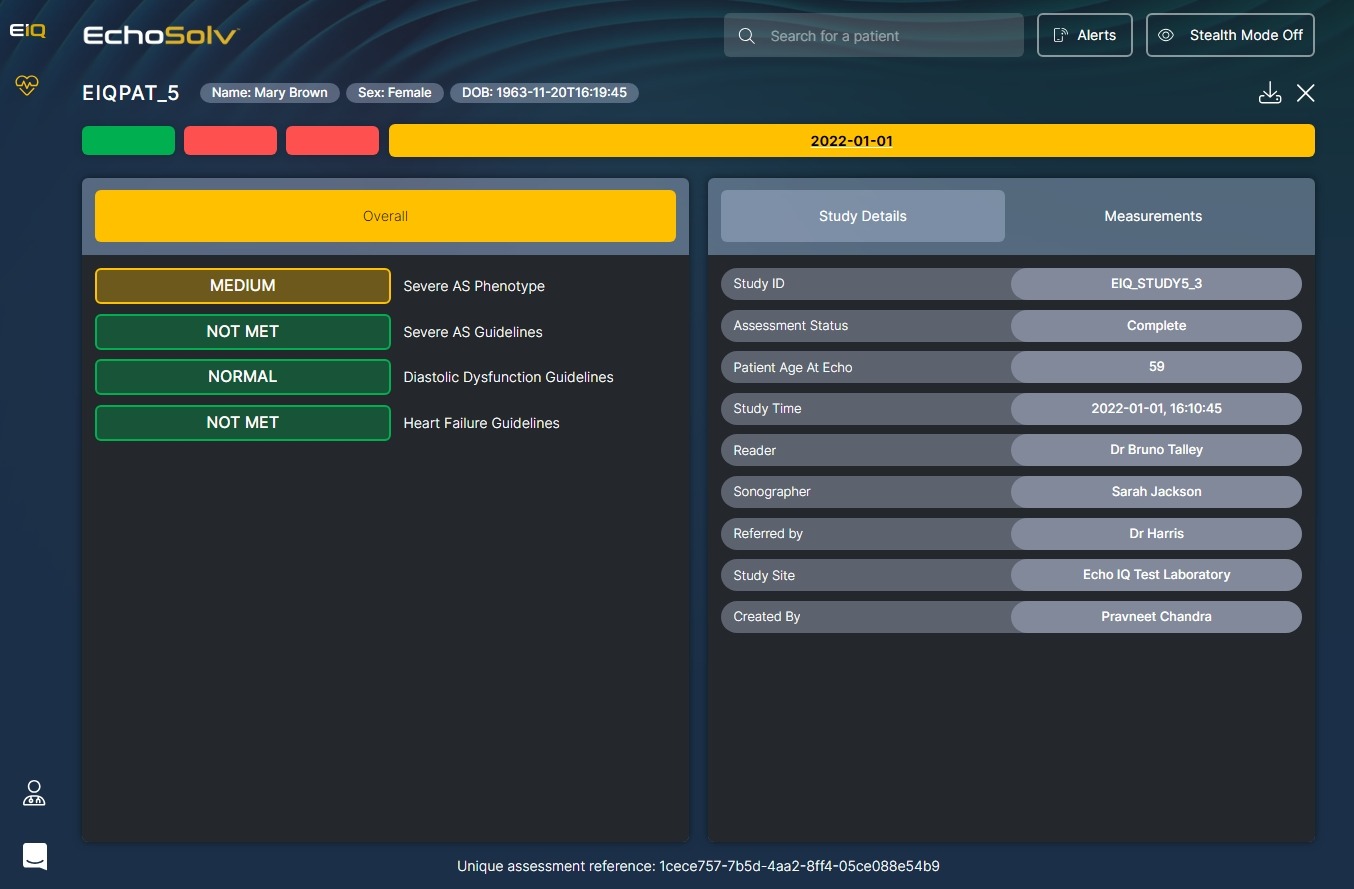
Identification of patients within guidelines, and patients additionally identified as High and Medium risk for the Severe AS phenotype using AI*. Key measurements and outcomes for Severe Aortic Stenosis displayed alongside results.
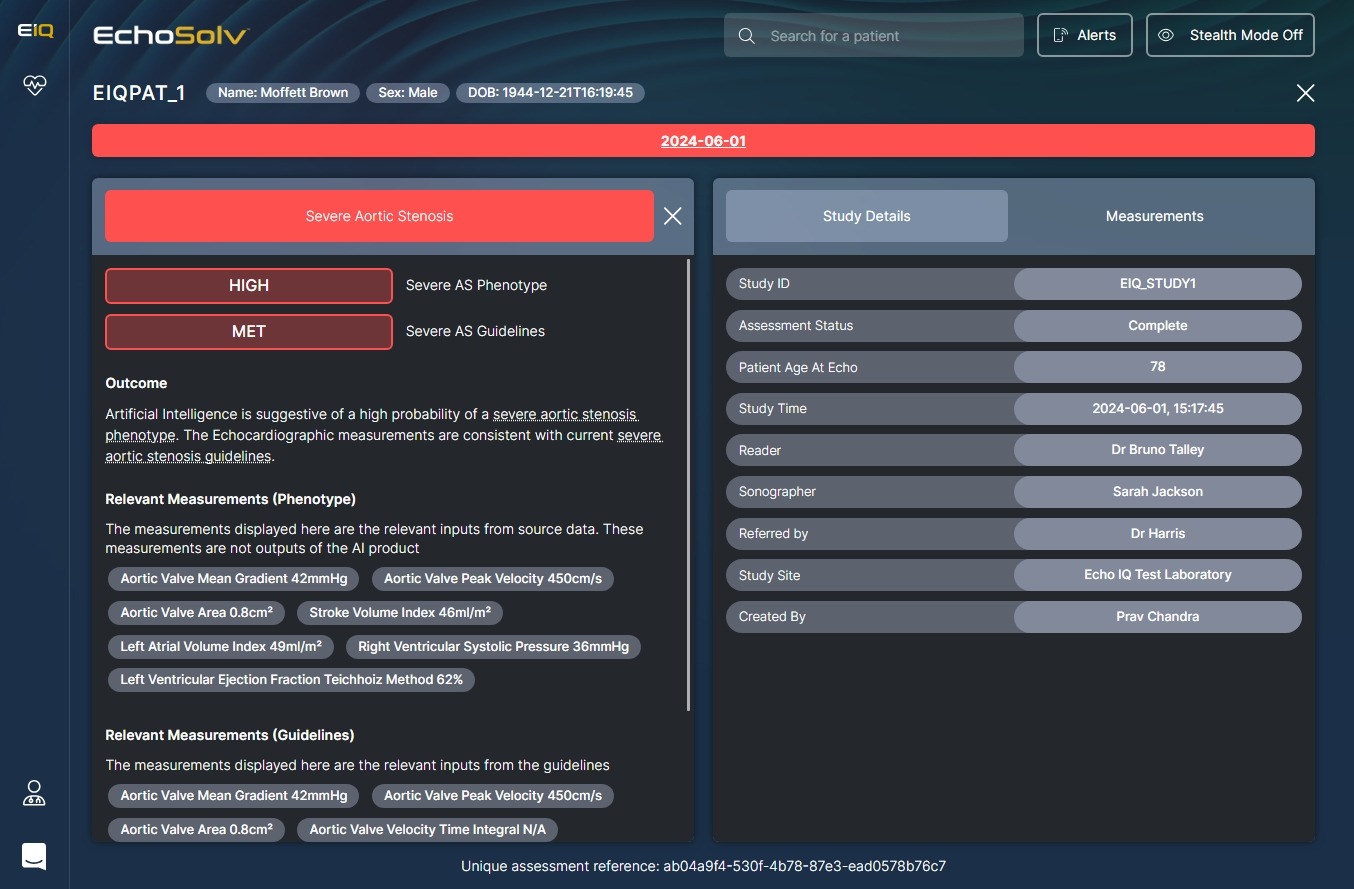
Identification of patients within guidelines for Diastolic Dysfunction (DD). Key measurements for DD displayed alongside results.
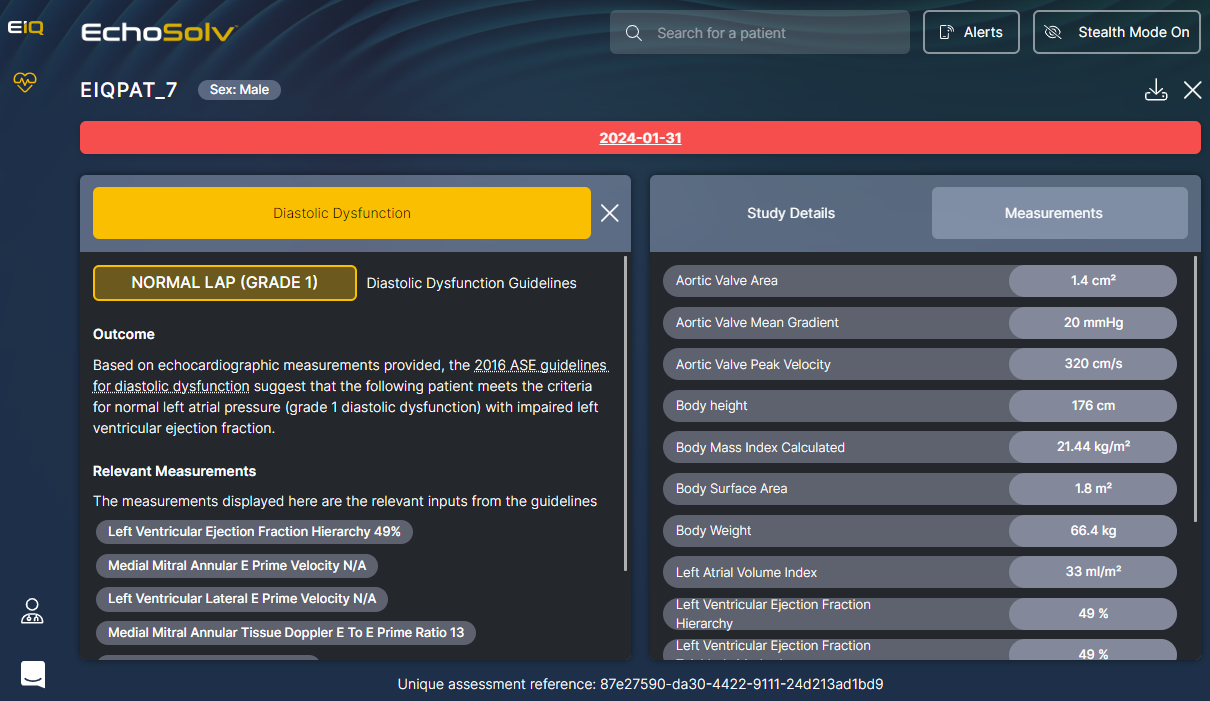
Identification of patients within guidelines for heart failure (HF). Key measurements for HF grades displayed alongside results.
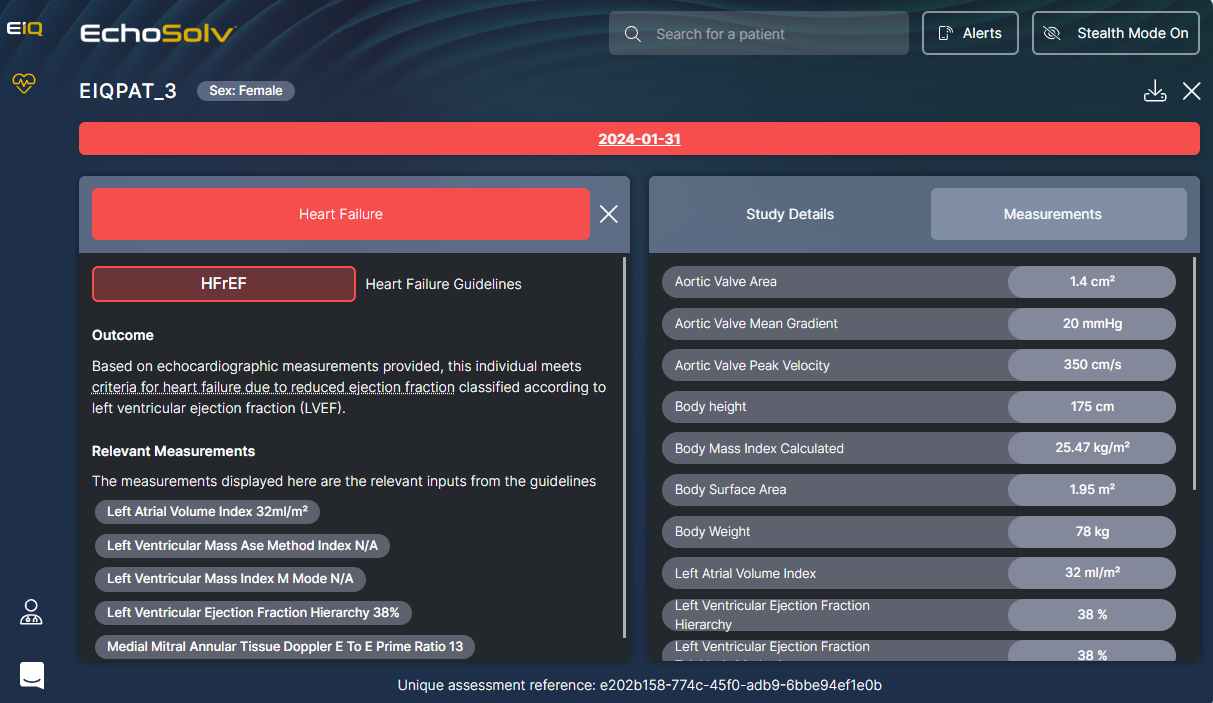
*EchoSolv™ AS phenotyping capabilities are available in the USA and New Zealand, with regulatory clearance planned for Australia.

Automatic identification of your at risk patients. Quickly find the patients you are interested in, or review the status of your patient cohort as a whole with powerful filtering options.

Risk context at a glance — all EchoSolv™ results and echo data in one place. Easy to navigate to patient’s current and historical studies, as well as to view all echo measurement data.

Identification of patients within guidelines, and patients additionally identified as High and Medium risk for the Severe AS phenotype using AI*. Key measurements and outcomes for Severe Aortic Stenosis displayed alongside results.

Identification of patients within guidelines for Diastolic Dysfunction (DD). Key measurements for DD displayed alongside results.

Identification of patients within guidelines for heart failure (HF). Key measurements for HF grades displayed alongside results.
*EchoSolv™ AS phenotyping capabilities are available in the USA and New Zealand, with regulatory clearance planned for Australia.
EchoSolv™ provides access to at-risk patients whether you are at your desk, or away from the clinic.
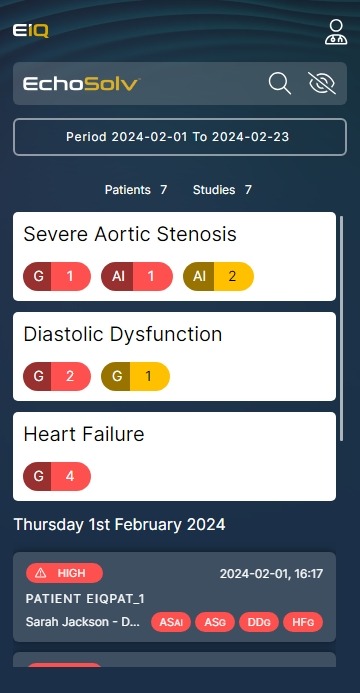



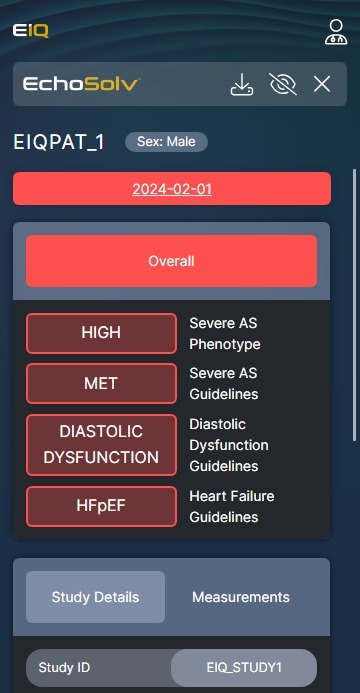

EchoSolv™ provides access to at risk patients whether you are at your desk, or away from the clinic.
Find your at risk patients wherever you are.
Get notified when one of your patients has been flagged for high risk.
Access key disease information and all other echo measurements for your patient in one place.
EchoSolv™ enriches your clinical workflow without adding complexity.
Uniquely able to provide detections in under 3 seconds, EchoSolv™ detections will be available when you start to write your report.
With multiple integration options you can view the EchoSolv™ results alongside your other Echo images stored on your PACS, see the results directly on your cloud reporting software, access our easy to use app, or receive SMS and Email alerts for risk detections.
Multiple options to export your echo data and measurements giving you the ability to carry out your own cohort research.
You can generate PDF reports to include in patient files, or Results images can be written to your PACS.
Want to use EchoSolv™ in class or as part of a talk, use stealth mode to hide PHI.
Cardiologists need only one login to access multiple organisations. With all accounts protected by multi-factor authentication.
Comprehensive audit trails and role based access controls give you the ability to ensure only the people you want have access to your data.
Echo IQ is certified for SOC2 Type II and HIPAA compliance by independent auditors. We also undertake annual penetration testing of our systems.
Health data is encrypted and stored in US data centres for North American customers and Australian data centres for Asia/Pacific.
Test the fastest and most accurate echo AI for yourself.
Retrospective and live studies in under 3 seconds.
Identifies 100% of in-guideline patients.
Connects to your PACS. No EMR integration required.
Test the fastest and most accurate echo AI for yourself.
Retrospective and live studies in under 3 seconds.
Identifies 100% of in-guideline patients.
Connects to your PACS. No EMR integration required.
Our work in aortic stenosis has been widely published. To the best of our knowledge, here’s how recent studies leveraging AI to detect aortic stenosis compared.
Leading cardiologists around the world rely on EchoSolv™ to ensure consistency in their practice.
Whether you are a large enterprise network, hospital, or small clinic, we have flexible pricing models consistent with your needs.
We made sure adding EchoSolv™ to your workflow for real-time analysis is not a project.
Easily connect EchoSolv™ to your DICOM compliant PACS server using EchoIQ Connect with a 15 minute install.
Straight away you will see EchoSolv™ results in our app, and results images appear alongside your Echo images in your existing viewer software.
Great news we can directly connect EchoSolv™ to one of our reporting system partners.
Giving you access to the power of EchoSolv™ in your existing reporting software.
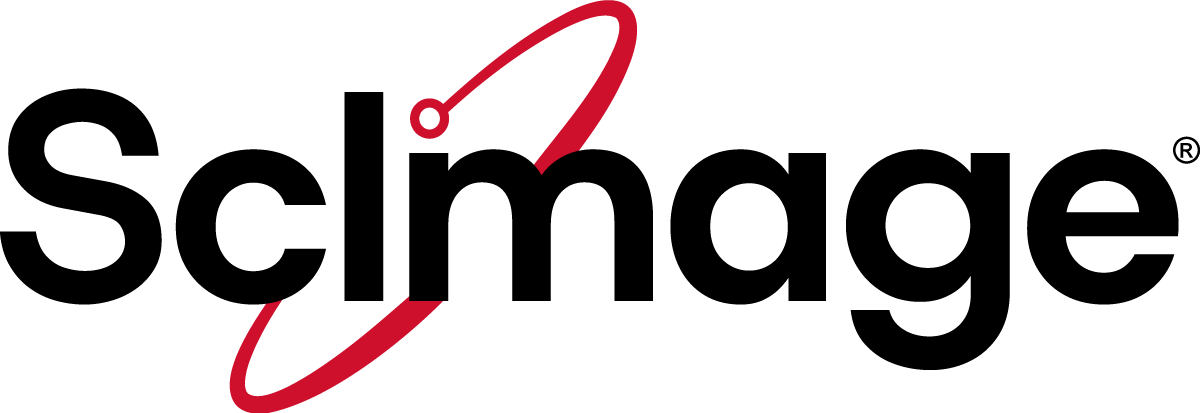



Don’t worry, we have you covered. Your Echo Machine can talk directly to our EchoIQ Connect software to enable real-time assessments.
We can run EchoSolv™ assessments on DICOM SR files you send us.
If you have anything else you want to ask, reach out to us.
Echocardiographic measurement data is passed into our proprietary algorithm which is based on learnings from the largest database of echocardiograms globally. The AI uses the echocardiographic measurements to determine the probability of the presence of AS phenotype (i.e at risk patients). The final output of the software considers both the AI probability of AS phenotype as well as evaluating the echocardiographic measurements against the European Society of Cardiology/European Association for Cardio-Thoracic Surgery guidelines.
Our software can be used in 2 ways. 1) We can perform real-time assessments via secure cloud API in 1.5 seconds on average. 2) We can perform bulk historical assessments (quality audit) in under a few minutes.
99.98% accuracy. EchoSolv™ is a decision-support tool (not in-vitro diagnostic) providing risk stratification to support cardiologist decision making.
EchoSolv™ takes the measurements captured across all images in the study and maps them into a multi-dimensional AI model. The AI considers what’s happening using aortic velocity and gradient. Instead of using the aortic valve area, it examines all remaining measurements (including ventricular, atrial, and pulmonary and right heart measurement data) to determine the impact on the aortic valve area. The software then provides a probability of severe aortic stenosis. This automatically takes all AS scenarios into account including low-flow aortic stenosis, paradoxical low flow low-gradient and normal-flow low-gradient AS. The software provides two outputs, firstly it provides an alert for all patients that meet the AHA guidelines for severe AS, secondly it provides a probability of the severe AS phenotype (i.e at risk patients), providing unique insights not provided by other methodologies.
Age, BMI, LV Ejection Fraction and Peak Aortic Velocity.
The AI has been trained using multidimensional clusters with data from over 1,000,000 echocardiograms. Any missing data is imputed using a multiple imputation model that has been tested across the entire data set. Bad (i.e. inaccurate) measurement data is also imputed based on the variables from all the other datapoints that were captured.